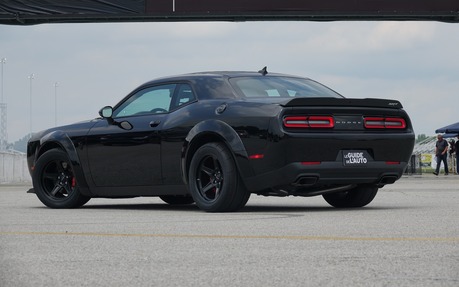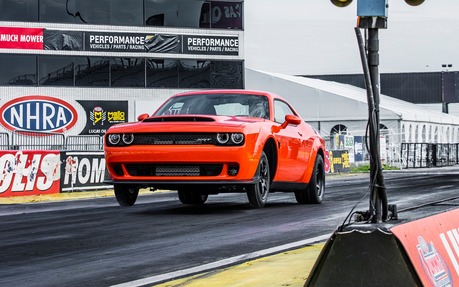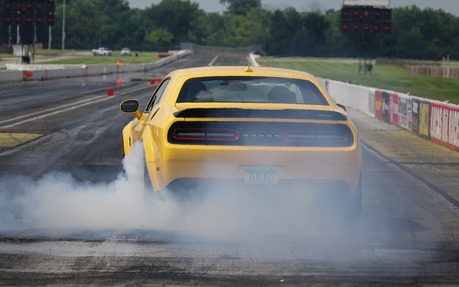2018 Dodge Challenger SRT Demon: Hell Hath No Fury
INDIANAPOLIS, Indiana – An entire book could be written about the new Challenger SRT Demon and its bold personality, singular design and untold secrets. In fact, the fanatics at the SRT performance division have already written and printed this book for 300 lucky Canadians who have $110,000 to buy this very exclusive car (our neighbours to the south will get 3000 units).
Every Demon owner will receive a complete leather-bound book detailing how to get the most out of this hefty all-American coupe. The short answer, of course, is on a dragstrip. Additional pages will also be provided to record personal best times, conditions and settings. There’s all that, plus the usual recommendations for operating for a new car under warranty. And there’s a lot to say about this beautiful beast.
- Also: 2018 Dodge Challenger SRT Hellcat Widebody: Pricing Revealed
- Also: 2017 Dodge Challenger R/T: Keeping it Old School
Record-setting right from the start
The Demon has already made its way into several record books, including the granddaddy of them all, the Guinness Book of World Records, which confirms that the Demon was the first production car to pop a wheelie and cover a distance of 0.89 metres (2.92 feet). For a car that weighs 4280 lbs (1941 kg), 58% of which sit on the front wheels, that’s a mind-blowing accomplishment.
Then there’s the 9.65-second quarter-mile time completed at 225 km/h in Gainesville, Florida. Once this performance was confirmed, the vehicle was banned from competition by the omnipotent National Hot Rod Association (NHRA). According to their stringent guidelines, any car that can go that far in less than 10 seconds has to be equipped with a complete safety cage, a parachute and a whole host of other safety features.
Performance like that from a production car doesn’t happen by accident and isn’t due to sheer power alone. Rather, that kind of output is the fruit of a tireless effort by a group of engineers at Dodge’s SRT Division. These performance freaks wanted to create a car to relive the golden age of muscle cars that they missed, but long for fifty years later, thanks to the likes of the 426 Hemi and 440 Magnum.
However, the 2018 Dodge Challenger SRT Demon can go from race car to docile coupe at the push of a few buttons thanks to modern technologies.
A fiery engine and battled-tested main components
The Demon’s engine is not just the Hellcat’s 6.2-litre 707-horsepower supercharged mill taken to the next level. Its V8 is equipped with a 2.7-litre compressor (instead of 2.4) that pushes 14.5 psi (instead of 11.6 psi) at 6500 rpm (versus 6200 rpm in the Hellcat).
Its hood features the largest air intake ever seen on a production model, plus there are round intakes that replace two headlights and others beneath the fender liners. Thanks to all this air, the V8’s output jumps to 808 horsepower (confirmed by the SAE) and 717 lb.-ft. of torque with super unleaded gasoline. These figures soar to 840 horsepower and 770 lb.-ft. when you take the optional engine controller and use gas with an octane rating of 100 or more. This river of fuel is discharged by not one, but two pumps.
Dozens of engine and gear components had to be modified and reinforced to transmit and withstand all that power, disperse the incredible heat that it generates and ensure reliability and consistency in extreme conditions. The compressor, pistons, connecting rods, forged crankshaft, distribution (valves, springs) and injection all had to be made sturdier than in the Hellcat. Same goes for the driveshaft, differential and eight-speed automatic gearbox.
To perfectly control the incredible heat that this internal combustion engine produces, the vehicle’s engineers decided to redirect the air conditioning coolant to cool the compressor’s heat exchangers. This is a clever trick, just like the decision to circulate the coolant and activate the fans when the V8 is stopped to keep it from overheating.

Divinely civilised on the road
I can confirm that, over the course of an afternoon, a half-dozen Demons repeatedly unleashed intense burnouts and passes on the Lucas Oil Raceway’s straightaway without the slightest mechanical issue or loss of power, all in the hands of a bunch of journalists. They are exceptionally robust machines, even in extreme conditions like oppressive heat.
While my colleagues ran to the track, I headed in the opposite direction to take the perfect Demon—black with black interior—for a road drive. I wanted to know how this car with the off-the-charts specs would handle in normal driving situations.
On the road, the Demon is like a big teddy bear—or at least a good-natured grizzly—even when you use the red key that sets the engine at 808 horsepower instead of the black key that limits output to 500 horsepower. The only hint of its wild side was the metallic whistle of the big compressor during even the slightest accelerations. Fans are going to love that.
Modern Challengers are roomy and comfortable, and the Demon is no exception. The engineers reduced the firmness of the suspension springs by 35% in front and 28% in back to maximize weight transfer towards the rear in acceleration. This is the key to its record-setting performance. The roll bars are hollow and more flexible, by 75% and 44% respectively, for the same reasons.
The Demon leaves the sharp handling to the Hellcat, particularly the new Widebody which shares its broader physique (a 9-cm gain). It also flaunts more pronounced fenders covering the custom-made 315/40R18 Nitto NT05R tires. These are the first drag tires to be mounted on a production car and they have twice the grip of the Hellcat’s tires. The Demon offers a smooth and easy ride, even on challenging surfaces. Of course, this probably won’t be the case when it rains, considering the smooth tires only have two big grooves.

A devil on the track
To get the most out of the Demon, opt for the Demon Crate that Dodge offers for a token charge of $1. It includes different black rims fitted with really narrow and light 4.50/28.8-18 M&H Racemaster front tires for use on the dragstrip only. So there’s a second pair of rear tires for regular use.
The body also contains the electronic device that calibrates the engine for 100+ octane gasoline, a huge conical air filter and various tools emblazoned with the Demon logo, like a rechargeable impact wrench for the wheel lug nuts, and a big hydraulic jack. There’s also a bag and a support to transport all these items in the trunk. The body also comes with a plate engraved with the name of the vehicle owner and the serial number.
The Demon is 91 kg lighter. Ten of those come from the removal of the audio system and its 16 speakers, and more than 50 were shaved off by eliminating the passenger seat and rear bench. However, you can add these back for a mere $1 each as well, and then remove them again when you want to drive around the track.
They saved 7.2 additional kg compared to the Hellcat by using 360-mm discs instead of 390-mm discs, and four-piston Brembo callipers rather than the six. Repeated braking isn’t as important for the Demon, but I noticed that it struggled a bit on the dragstrip because of its narrow front tires. To be fair, it was at the end of the day and the vehicle was travelling at upwards of 220 km/h at the end of a quarter-mile.
The key was to do a solid burnout to clean and heat the tires and then to have a perfect start. The first step is the LineLock system that applies the front brakes and lets the rear tires skid as long as you want. Clouds of blue smoke included.

To launch the vehicle, there’s the TransBrake. Professional drag racers have been using it for ages, but this is the first time it’s been added to a production car. Use the two levers behind the steering wheel to block the automatic gearbox’s output shaft and keep the car in place. Then increase to about 1700 rpm, release the second lever and the Demon literally pounces while the V8 emits a husky, fabulous roar. It will take your breath away. According to Dodge, you can expect 1.8 g off the line on a prepared track. I have no trouble believing that.
In Drag mode, the Bilstein configurable dampers are at their softest when relaxed as you start. This allows the front end to raise off the ground while the rear wheels bear as much weight as possible. As soon as you raise your foot, the dampers firm up again for maximum stability. Electronics sure are great!
We’d need to write another long-winded article to describe the various charts and special functions available via the Demon’s sizeable Uconnect screen. Be prepared for lots of useful information and hours of fun.
Dodge and its SRT group hope to stand out by creating unique performance cars that are different from the Camaro and Mustang. They’ve already had a lot of success with the Hellcat, but the lastest Demon is the real deal. It’s like the birth of a legend. Hats off to the engineers for a job well done.
| Test drive report | |
| Test model | 2018 Dodge Challenger |
|---|---|
| Trim level | SRT Demon |
| Price range | $32,345 – $109,995 |
| Price as tested | CA$109,995 |
| Warranty (basic) | 3 years/60,000 km |
| Warranty (powertrain) | 5 years/100,000 km |
| Fuel economy (city/highway/observed) | N/A |
| Options | Caisse Demon (1 $), siège passager avant (1 $), banquette arrière (1 $) |
| Competitive models | Bugatti Chiron |
| Strong points |
|
| Weak points |
|
| Editor's rating | |
| Fuel economy | Colossal, despite Eco mode. |
| Comfort | Roomy, with one comfortable standard seat and two others on option. |
| Performance | Acceleration on par with the Bugatti Chiron, a superbike or a Saturn rocket. |
| Infotainment | User-friendly and filled with fun and useful features. |
| Driving | Truly exhilarating on a dragstrip. |
| Overall | An exotic and totally unique American car. |
